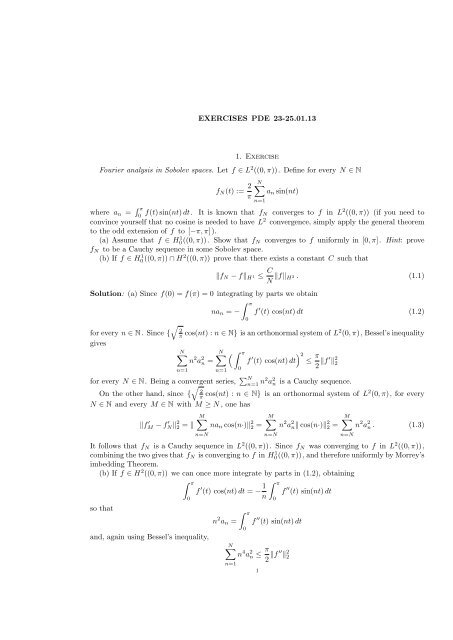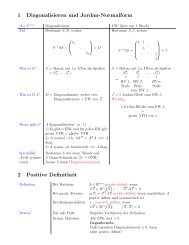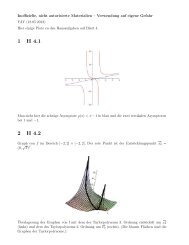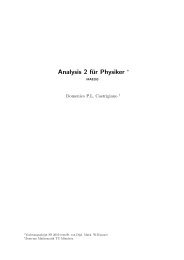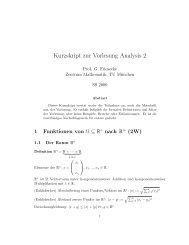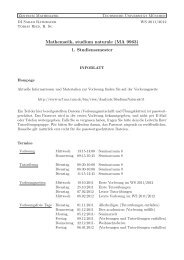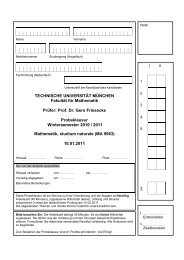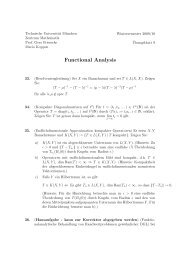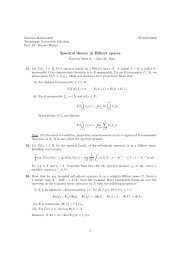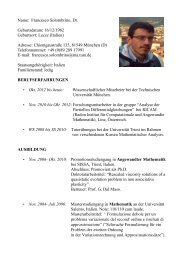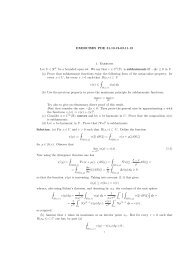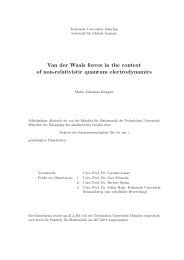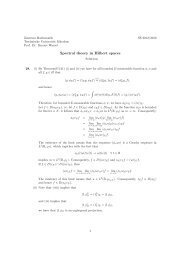EXERCISES PDE 23-25.01.13 1. Exercise Fourier analysis in ...
EXERCISES PDE 23-25.01.13 1. Exercise Fourier analysis in ...
EXERCISES PDE 23-25.01.13 1. Exercise Fourier analysis in ...
You also want an ePaper? Increase the reach of your titles
YUMPU automatically turns print PDFs into web optimized ePapers that Google loves.
2 EX11for every N ∈ N. Comb<strong>in</strong><strong>in</strong>g this with (<strong>1.</strong>3) for every N ∈ N and every M ∈ N with M ≥ N , onehasM∑‖f M ′ − f N‖ ′ 2 2 = n 2 a 2 n ≤ 1 ∑MN 2 n 4 a 2 n ≤π2N 2 ‖f ′′ ‖ 2 2 .n=Nn=NWhen M goes to +∞ we therefore obta<strong>in</strong>√ π‖f ′ − f N ′ 1‖ 2 ≤2 N ‖f ′′ ‖ 2S<strong>in</strong>ce by Po<strong>in</strong>caré’s <strong>in</strong>equality‖f − f N ‖ 2 ≤ π‖f ′ − f N ′ ‖ 2we get that‖f − f N ‖ H 10 ((0,π)) ≤√ π2 (1 + π) 1 N ‖f ′′ ‖ 2as required.□2. <strong>Exercise</strong>Céa’s Lemma: Consider a symmetric, bounded, coercive bil<strong>in</strong>ear form B : H ×H → R on a Hilbertspace H , that isB(u, v) = B(v, u) , B(u, v) ≤ C 1 ‖u‖ H ‖v‖ H , B(u, u) ≥ c 0 ‖u‖ 2 H .(a) Fix a l<strong>in</strong>ear cont<strong>in</strong>uous functional F : H → R. Justify that there exists a unique u ∈ H suchthatB(u, v) = F (v)for every v ∈ H .(b) Fix additionally an N -dimensional subspace H N of H . Justify the follow<strong>in</strong>g fact: there exista unique approximate solution u N ∈ H N , that is a unique u N ∈ H N such thatfor every v N ∈ H N .(c) Prove the follow<strong>in</strong>g equalityB(u N , v N ) = F (v N )B(u − u N , u − u N ) + B(v N − u N , v N − u N ) = B(u − v N , u − v N ) (2.1)for every v N ∈ H N . Deduce Céa’s estimate:√C‖u − u N ‖ H ≤ 1c 0<strong>in</strong>f{‖u − v N ‖ : v N ∈ H N } . (2.2)(d) Consider now H = H0 1 ((0, π)) and H N := span{t ↦→ s<strong>in</strong>(nt) : n = 1, . . . , N}. For a(x) ∈C 1 [0, π] with 1 ≤ a(x) ≤ 2 for every x and f ∈ L 2 ((0, π)) setB(u, v) :=ˆ π0a(t) u ′ (t) v ′ (t) dt (2.3)and F (v) := ´ π0 f(t) v(t) dt. Check that u and u N as <strong>in</strong> (a) and (b), respectively, exist, and showthat u N → u <strong>in</strong> H 1 0 ((0, π)) as N goes to +∞. If additionally u ∈ H 2 ((0, π)) show that there existsa constant C such that‖u − u N ‖ H 1 ≤ C N ‖u‖ H 2 .Solution: (a) follows from the Lax-Milgram theorem. The same holds for (b) s<strong>in</strong>ce the restriction ofB to the Hilbert subspace H N × H N is clearly bil<strong>in</strong>ear, coercive and cont<strong>in</strong>uous.(c) By bil<strong>in</strong>earity and simmetry of the form B we haveB(u − u N , u − u N ) = B(u, u) − 2B(u, u N ) + B(u N , u N )B(v N − u N , v N − u N ) = B(v N , v N ) − 2B(u N , v N ) + B(u N , u N )B(u − v N , u − v N ) = B(u, u) − 2B(u, v N ) + B(v N , v N )
EX11 3therefore (2.1) is equivalent to prove that2(B(u N , u N ) − B(u, u N ) + B(u, v N ) − B(u N , v N )) = 0 .This can be easily proved to be true by observ<strong>in</strong>g that by def<strong>in</strong>ition of u and u N , for every v N ∈ H None hasB(u, v N ) = F (v N ) = B(u N , v N )and <strong>in</strong> particular, for v N = u N ,B(u, u N ) = B(u N , u N ) .Now, by (2.1), and the coercivity and cont<strong>in</strong>uity of B we get for every v N ∈ H Nc 0 ‖u − u N ‖ 2 H ≤ B(u − u N, u − u N ) ≤ B(u − u N , u − u N ) + B(v N − u N , v N − u N ) =B(u − v N , u − v N ) ≤ C 1 ‖u − v N ‖ 2 Hwhence√C‖u − u N ‖ H ≤ 1c 0‖u − v N ‖ Hfor every v N ∈ H N . Tak<strong>in</strong>g the <strong>in</strong>fimum <strong>in</strong> the rigth-hand side gives (2.2).(d) To prove existence of u and u N when B is given by (2.3), it suffices to check that the Lax-Milgram theorem can be applied. The only relevant po<strong>in</strong>t to this end is to prove coercivity of B ,which follows from the Po<strong>in</strong>caré <strong>in</strong>equality. Namely, one hasB(u, u) ≥ ‖u ′ ‖ 2 2 ≥ 11 + π 2 ‖u‖2 H . 1It follows now from the previous exercise that<strong>in</strong>f{‖u − v N ‖ H 10 ((0,π)) : v N ∈ H N } → 0as N goes to +∞. In particular, by (<strong>1.</strong>1), if u ∈ H 2 one has for every N ∈ N<strong>in</strong>f{‖u − v N ‖ H 10 ((0,π)) : v N ∈ H N } ≤ C N ‖u‖ H 2 .Comb<strong>in</strong><strong>in</strong>g these two facts with (2.2) gives the conclusion.□3. <strong>Exercise</strong>Consider a bounded smooth open subset Ω ⊂ R N , and Γ D ⊂ ∂Ω with H N−1 (Γ D ) > 0. LetH 1 Γ D(Ω) := {u ∈ H 1 (Ω), T u = 0 on Γ D } ,with T the trace operator. For λ > 0 def<strong>in</strong>eˆB λ (u, v) = ∇u(x) · ∇v(x) dx − 1 ˆT u(ξ) T v(ξ) dH N−1 (ξ)Ω λ ∂Ωfor u and v ∈ HΓ 1 D(Ω). Prove that, when λ is sufficiently large, for every f ∈ L 2 (Ω) there exists aunique u f ∈ HΓ 1 D(Ω) such thatˆB λ (u f , v) = f(x) v(x) dxfor every v ∈ H 1 Γ D(Ω). H<strong>in</strong>t: does the Po<strong>in</strong>caré <strong>in</strong>equality apply <strong>in</strong> H 1 Γ D(Ω)?Solution: Follow<strong>in</strong>g the h<strong>in</strong>t, let us first prove that there exists a constant C such thatΩ‖u‖ L2 (Ω) ≤ C‖∇u‖ L2 (Ω) (3.1)for every u ∈ HΓ 1 D(Ω). To prove this, it suffices to argue as <strong>in</strong> the proof of the Po<strong>in</strong>caré-Wirt<strong>in</strong>ger<strong>in</strong>equality (Theorem 1, Section 5.8.1 <strong>in</strong> Evans’book): contradict<strong>in</strong>g (3.1) would produce the existenceof a sequence u n <strong>in</strong> HΓ 1 D(Ω) with ‖u n ‖| L2 (Ω) = 1 for every n which is converg<strong>in</strong>g to a constant c <strong>in</strong>H 1 (Ω). By cont<strong>in</strong>uity of the trace operator, HΓ 1 D(Ω) is a Hilbert subspace of H 1 (Ω), so it must bec = 0, s<strong>in</strong>ce this one is the only constant <strong>in</strong> HΓ 1 D(Ω). On the other hand, by strong L 2 convergencewe must have ‖c‖ L 2 (Ω) = c|Ω| 1 2 = 1, and this gives a contradiction.
4 EX11Now, let C be given by (3.1), and let C T the cont<strong>in</strong>uity constant of the trace operator. Assumethat λ > C T (1 + C 2 ). Then for every u ∈ HΓ 1 D(Ω) one has, by the cont<strong>in</strong>uity of the trace and by(3.1), thatB λ (u, u) = ‖∇u‖ 2 L 2 (Ω) − 1 λ ‖T u‖2 L 2 (∂Ω) ≥ 11 + C 2 ‖u‖2 H 1 (Ω) − C Tλ ‖u‖2 H 1 (Ω) = c 0‖u‖ 2 H 1 (Ω)with c 0 := 11+C− C 2 Tλ> 0 due to the assumption on λ. Therefore for λ > C T (1 + C 2 ) the bil<strong>in</strong>earform B λ is coercive on HΓ 1 D(Ω). For any λ > 0 one has also by the Cauchy-Schwarz <strong>in</strong>equality andthe cont<strong>in</strong>uity of the trace operator thatB λ (u, v) ≤ (1 + C Tλ )‖u‖ H 1 (Ω)‖v‖ H 1 (Ω)so that B λ is cont<strong>in</strong>uous. The conclusion follows by the Lax-Milgram theorem.□


